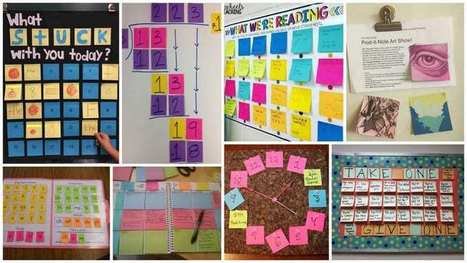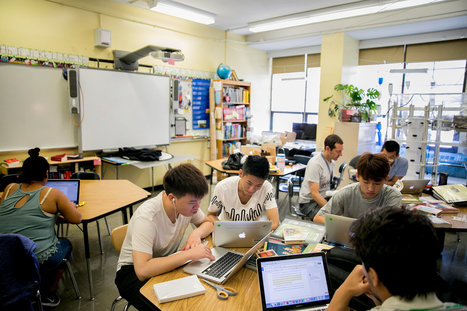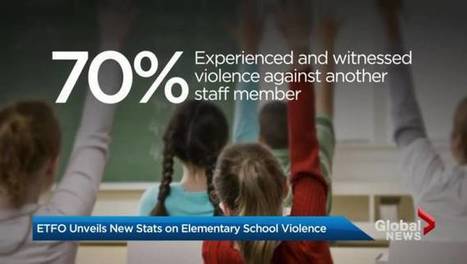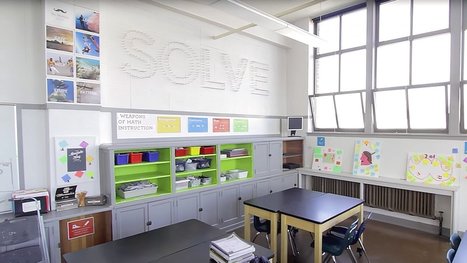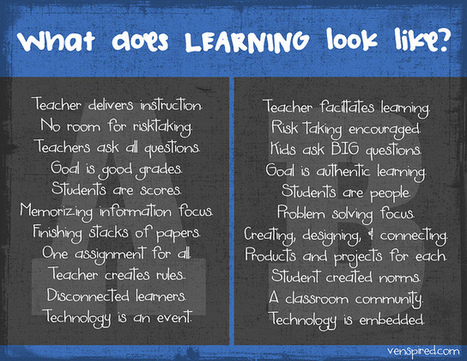 Your new post is loading...
 Your new post is loading...

|
Scooped by
John Evans
|
Sticky notes got their start nearly 40 years ago, when 3M introduced the now-classic yellow Post-it Notes. In the years since, their popularity has skyrocketed, and they’re now available in every shape, size, and color you can imagine. They have endless applications, especially in schools; teachers use sticky notes for math, reading, art, planning, and so much more. Here are 25 clever ways to use sticky notes in the classroom.

|
Scooped by
John Evans
|
"One thing is for sure, and that is you cannot walk into Christmas activities with your eyes closed! What for most children is a time of excitement and fun, for others is sensory overload.
Our preparation for Christmas starts with that thought in mind. The school SENCo circulates a reminder in mid-November, a set of questions to consider about the pupils in our care. These include questions like:
* Do you know what Christmas is like for this child? What takes place? What traditions events will take place at home? Where? Who with?
* What sensory sensitivity issues might need to be considered? * Does this child know what will happen in school? How will routines change? How will we share these with the children?"

|
Scooped by
John Evans
|
When a colleague invited Joy Kirr to a professional development day featuring the Scottish design thinking expert Ewan McIntosh she didn’t think it would be life changing. She was flattered to be asked, and wanted to make the most of the opportunity, but her experience of professional development up to that point didn’t lead her to believe it would be Earth-shattering. But then, McIntosh gave the teachers assembled a simple task: Pick one problem in your school and start working on it today.
Kirr, like most teachers, can think of a lot of structural problems influencing her classroom, but she decided to focus on something she could control: reading. Kirr teaches seventh grade English Language Arts, and was troubled that the curriculum only required students to read one book per quarter. She thought they should be reading a lot more than that, and she thought the rubric her school used was designed to catch kids who didn’t read. She knew there were kids getting A’s on that test who hadn’t read the book. There had to be a better way.

|
Scooped by
John Evans
|
For generations, cartoons and comics have been used for entertainment purposes, but what if they were used for more? Today, educators are using cartoons as a unique way to spark engagement in the classroom.
According to Teach.com, “Emerging research shows that comics and graphic novels are motivating, support struggling readers, enrich the skills of accomplished readers and are highly effective at teaching sometimes dull or dry material in subject areas such as science and social studies.” Students enjoy viewing comics, discussing comics, and creating comics.
If you are new to the idea of using cartoons in the classroom, the first thing you must understand is that the terms cartoons and comics are used interchangeably. Traditionally, a cartoon refers to a single-panel image (such as a political cartoon), whereas a comic refers to a multi-panel strip of images. As you will see, it is easy to use both forms in the classroom to capture your students’ attention.

|
Scooped by
John Evans
|
Technology is changing the world at a rapid pace, and education isn’t exempt from the effects of that. Social media, in particular, is one of the greatest influences of our time — not just on young people, but on culture in general — encouraging social connections and enabling the exchange of thoughts and information on a global scale.
And although it has its drawbacks (peer pressure, bullying, access to questionable content, and its addictive nature, to name a few), there are also tremendous benefits when it comes to social networks — and let’s face it, they’re not going anywhere.

|
Scooped by
John Evans
|
Few middle schoolers are as clued in to their mathematical strengths and weakness as Moheeb Kaied. Now a seventh grader at Brooklyn’s Middle School 442, he can easily rattle off his computational profile.
“Let’s see,” he said one morning this spring. “I can find the area and perimeter of a polygon. I can solve mathematical and real-world problems using a coordinate plane. I still need to get better at dividing multiple-digit numbers, which means I should probably practice that more.”
Moheeb is part of a new program that is challenging the way teachers and students think about academic accomplishments, and his school is one of hundreds that have done away with traditional letter grades inside their classrooms. At M.S. 442, students are encouraged to focus instead on mastering a set of grade-level skills, like writing a scientific hypothesis or identifying themes in a story, moving to the next set of skills when they have demonstrated that they are ready. In these schools, there is no such thing as a C or a D for a lazily written term paper. There is no failing. The only goal is to learn the material, sooner or later.

|
Scooped by
John Evans
|
Being quiet, it seems, is regarded as a deficit that needs to be pointed out and fixed. Throughout the years, few teachers bothered asking why he was so quiet and hesitant to share his thoughts. It wasn’t until my son’s fourth-grade year when a teacher helped him come out of his shell. What made this teacher special? He took the time to talk with my son and get to know him personally, despite the fact he was quiet. He made an effort to find ways for him to contribute without being the center of attention.
Now, my son is going into eighth grade now and while he’s still my shy guy, he may actually raise his hand a few times a year without prompting. Progress!
So why am I sharing this personal story? It has something to do with you, fellow teacher. Soon another school year will begin and a new batch of students will sit before you. The grade level or content you teach doesn’t matter, you will have them sitting in your room: the quiet kids. They don’t cause trouble and for the most part they earn good grades. But these are the kids that tend to fade into the background and slip through the cracks. The ones who are so often overlooked.

|
Scooped by
John Evans
|
Close your eyes and picture the most recent math class you taught. Who is doing the math? Who is doing the talking? Who is doing the thinking? Three years ago, my answer would have been “me”—the teacher. My students were doing math, but I was probably telling them how to think and what to do most of the time.
My big aha moment was being introduced to the research of Peter Liljedahl, a professor at Simon Fraser University. Liljedahl proposes three strategies that you can implement in order to create what he calls the thinking classroom: Start with good problems, use visibly random groups, and work regularly on vertical nonpermanent surfaces. I started using these three strategies in my math classes, and they have been an absolute game-changer. I can confidently say that my students now do most of the thinking and talking in my classroom.

|
Scooped by
John Evans
|
It was my first year of teaching in my own classroom, and I was learning that teaching first grade requires a lot of creativity. It was also pretty clear from the beginning that customizing any classroom for teaching efficiency and student engagement could easily cost a lot of money. This is why I started to explore and practice the amazing and amusing art of classroom hacking.

|
Scooped by
John Evans
|
Hey, math gurus! It’s that time of year again when teachers, students and mathematicians from all over the world honor the fun-loving irrational Greek figure pi (π). That’s right! March 14—or Pi Day—is just around the corner so be sure you don’t miss this opportunity to make a lasting impression on your math students!
The field of social media is a burgeoning area of communication, and one that educators cannot ignore. Facebook, Twitter, LinkedIn, Diigo, GooglePlus – these platforms for communication are not g...
Via Deepti Sachdeva, Dr. Susan Bainbridge
|

|
Scooped by
John Evans
|
By addressing student behavior with compassion -- even when they're acting out -- teachers can find productive ways to get kids on task or engage in relationship-building.

|
Scooped by
John Evans
|
"Makerspace is a rapidly growing trend in schools across the country, but to be honest, I’ve never implemented one myself, and I can’t quite picture the logistics of orchestrating a Makerspace. How do kids know what to do? How can you find out what they’re learning? How do you make time for that with all the other tasks crammed into the school day? And how do you keep the Makerspace from turning into a chaotic mess?
I wanted to get answers to these questions from teachers who have extensive Makerspace experience, and not just at the secondary level. So, I invited Cheryl Nelson and Wendy Goldfein of Get Caught Engineering to share how they’ve managed Makerspaces in their own classrooms and helped other elementary and middle school teachers get started, too. Thank you, Cheryl and Wendy, for sharing your experiences below!"

|
Scooped by
John Evans
|
A national study conducted by the Canadian Teachers’ Federation (CTF) revealed that at least four in 10 teachers per school jurisdiction have experienced violence from students.
In some jurisdictions, the number of teachers experiencing violence is as high as nine in 10.

|
Scooped by
John Evans
|
"Adversity and trauma reside in our biology, not our psychology and cognition, so we educators need to prime students’ brains for learning. This calls for a deeper understanding of how our brains develop and how they respond to adversity and trauma, and how building relationships and providing strategies that promote emotional regulation can positively affect students’ emotional, physiological, and cognitive health.
I’d like to describe some practices that not only address the stress response in the limbic brain areas, but also attend to sensory and motor systems in the brain stem area. Often these systems are compromised because of chronic stress that has neurobiologically reprogrammed how the brain of a child or adolescent responds to adversity."

|
Scooped by
John Evans
|
"If you’re thinking of completing your own classroom remake project, good for you. I’ve been helping teachers redesign classroom spaces for the past several years and have seen this process work for projects of all sizes.
The tips below can be used for smaller scale remakes right way. If you want to do something bigger, you can start planning immediately and schedule some time over a holiday or long weekend. Either way, much of the prep work can be done now or incrementally over a few weeks as a lead-up to a larger remake project.
Whether you’re looking to reorganize one corner or redesign an entire room, here are eight tips that may help you throughout the process."

|
Scooped by
John Evans
|
In the age of technology, when students use online databases for home research and when Khan Academy tutorials personalize learning, why does the 21st-century student come to school?
They come to see their friends. They come for the community. They come to be part of a classroom culture that motivates them to stick with the online tutorial and write that last paragraph in an essay.
For my first seven years of teaching, I spent the first week discussing class norms, dutifully posting group expectations on the wall, and asking that students sign an agreement to follow them in an effort to "determine class culture."
Turns out there's a quicker, more fun way to establish a positive atmosphere. With a little reinforcement, this positive culture lasts past the honeymoon of the first two weeks and into the second quarter when the gloves come off.
The secret is improv games. I call them warm-ups and play them once a week at the beginning of class. Many students tell me that warm-ups are the best part of their day.

|
Scooped by
John Evans
|
So what’s the secret? The MAGIC answer? The COOL tech tool that will automatically give my classroom the fun, joy, and happiness that can grow thriving students? Quite simply, it’s you, me, the teacher. Find the joy in yourself, in your work, your students, then find as many ways as you can to share it. All of the ways I do it work for me, but may not work for you. Actually, they work because I have refined my strategies with each year I teach (going on year 22). There are failures. Learn from them. Every teacher must find the joy they have for what they do and share it. Here are my tips:

|
Scooped by
John Evans
|
A couple of years ago I featured Jeopardy Rocks. Recently, Jeopardy Rocks changed its name to Factile and added some more features.
At its core Factile is a free platform for creating Jeopardy-style game boards to use in your classroom. Factile lets you create games and save them in your account to use whenever you need them. When you create your game you can include images in the answer display. One of the new features is a gallery of templates for creating games. You can browse the template gallery and make copies of the ones that you want to use in your classroom.

|
Scooped by
John Evans
|
While watching the Oscars tonight, I was intrigued to see a promotion that Walmart was running to celebrate the craft of film making. I don’t normally pay a lot of attention to commercials, but these ads managed to catch my attention, and I think that they have some interesting potential for teachers who are looking to add some creativity to video projects in their classroom.
Walmart contacted four award-winning directors, Seth Rogan and Evan Goldberg (Superbad, Neighbors), Antoine Fuqua (Southpaw, The Magnificent Seven), and Marc Forster (Monster’s Ball, The Kite Runner). They sent each of them a receipt with the same six items and challenged them to make a one minute movie that was centered around the six items on the receipt. You can learn more here, but take a look at the videos below to see what these talented directors came up with…
"A while ago, I created this poster A Tale of Two Classrooms. It wasn't meant as a statement of Classroom B is best. It wasn't even meant as a statement of Classroom A is awful. It was meant as a representation of Classroom A and B."
Via Kathleen McClaskey
|
 Your new post is loading...
Your new post is loading...
 Your new post is loading...
Your new post is loading...










